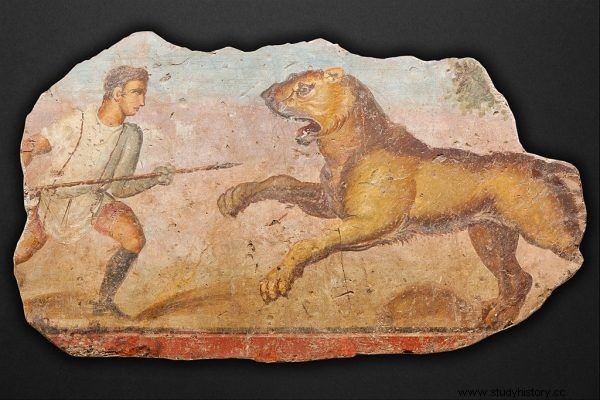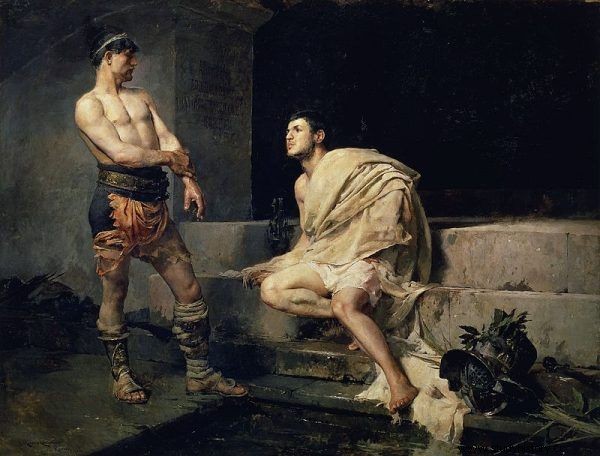The appearance of a gladiator in the arena always foreshadowed extreme emotions. Subjected to murderous training, the warriors had to face whatever foe they faced. Defeat meant death, but the bloodthirsty Roman people repaid with fervent adoration for the victory.
Ancient Rome is inextricably linked with the motto:"bread and circuses". And although it was different with the former, the inhabitants of the Eternal City never lacked the latter. The clashes between gladiators aroused their greatest enthusiasm. This kind of "entertainment" took root in Rome during the Punic Wars. It probably came from the Etruscan rites of human sacrifice.
Athletic fighters were recruited primarily from prisoners of war or criminals. Sometimes in their ranks there were also unmarried people. They chose to perform in the arena for various reasons - sometimes they were driven by desperation, and sometimes simply by the desire to experience an adventure or become famous.
Those who achieved the most spectacular and most numerous victories enjoyed recognition throughout the Empire. Publius Ostorius of Pompeii is considered the record holder of gladiatorial fights. Apparently, he fought as many as 51 duels in the arena! It was a real sensation. Usually one fighter withstood only a few clashes and died around thirty . And it's hardly surprising when you look at who - or with what - he had to win to survive ...

Gladiators with different weapons were often pitted against each other.
Warriors and fishermen
The fights between gladiators themselves could have terrified viewers with weaker nerves. All the more so because they were often diversified, pitting the fighting categories against each other. This was the case of the Samnite clashes with the "Netmen".
These first, enslaved soldiers from the Italian people fighting with Rome, were allowed to use their own weapons. They had heavy armor, a helmet and a shield. A sword or a spear served them as a fighting tool. Perfectly trained and experienced in battle, they were almost killing machines.
It was with them that warriors called retiarii - " had to fight netmakers ". They were relatively lowest in the hierarchy of gladiators. Their only weapons were ... a net and a trident. It evoked associations with fishermen, hence their name.
Due to modest combat equipment, their most common tactic was dodging. Retarius he eagerly moved from one end of the arena to the other, waiting for the right moment for a surprise attack. To defeat Samnita, he had to be incredibly fast and agile.
Fighters called andabatae, were also very emotional whose helmets did not have eye openings . They specialized in blind combat. They charged each other on horses, pointing at the enemy with the drawn spear.
Nature vs. "Culture"
However, gladiators did not fight only with each other. In places such as the Colosseum in Rome, even more cruel and barbaric duels took place in front of tens of thousands of spectators. During their course, people's opponents became wild, dangerous animals.

Tens of thousands of spectators watched the fights of gladiators from the stands.
The range of fighting "beasts" was extremely wide. In the arenas there were, among others, lions, tigers, bulls, bears, crocodiles, wild boars, pythons, and even ... seals. It happened that Caesar directed 500 warriors to fight against ... the same number of elephants! Perhaps the most popular among the audience were the rhinoceroses, although due to their innate, calm nature they had to be additionally stimulated to fight, for example by pricking them with spears.
Various methods were used to encourage the animals to fight. On their own, they often felt fear and did not want to go to the center of the amphitheater. Thousands of screaming throats terrified them. In order to scare them away, lit straw was thrown into their cages. Sometimes, to upset them, they were also chained together. Then, when released, they would attack whatever stood in their way.
It took a great deal of skill to face the creatures maddened with fear. No wonder the stories of muscular warriors who felled great beasts have become legendary. Their success was primarily due to proper training.

Only the most skillful gladiators had a chance in clashes with hungry, maddened predators.
For example, it has been found that a strong blow of a bear above the ear knocks it down on the spot. A remedy to defeat the lion was also found, although only the bravest reached for it. In order to strangle the animal, you had to first open its mouth, and then ... insert your arm into its esophagus and tighten it properly.
It is worth adding that not only trained warriors struggled with predators. People sentenced to death were sent to clash with them, and without any weapons. This fate befell Christians, among others, both men and women, in times of the greatest persecution of this religion. Naked convicts were usually tied to a pole in the center of the arena, after which the terrified and starved animal was released.
The sea in the heart of Rome
Real battles were organized in the amphitheaters to provide the sensation-seeking viewers as much as possible. Undoubtedly, the most spectacular were those at sea, carried out on a specially prepared, flooded area. Gladiators fought like pirates on board the ships.
Caesar was the first to introduce this spectacular point of the program. His successor, Octavian Augustus, perfected this form and ordered a great pit of water to be dug in Rome, along the bank of the Tiber. The site was three times larger than the Colosseum, which was built almost a century later. As many as 600 gladiators took part in one of the skirmishes there!
This was not a record, however. The largest naval battle in terms of scale was organized by Emperor Claudius several dozen years later. A total of as many as 19,000 people, gladiators and rowers took part in it . As you can guess, there was an unimaginable shambles - all for the entertainment of the crowd.
End of the dark age
The end of the cruel practice of gladiatorial fights brought about the spread of Christianity in the Roman Empire. Partly under the influence of the new religion, the blood games were gradually abolished. The first official act in this matter was the edict of Emperor Constantine the Great in 326, which forbade gladiatorial fighting.

Gladiatorial fights were not formally banned until the 4th century AD.
The old habits were dying for a long time. In the eastern part of the empire, bloody duels were practiced until AD 681 Only then did the era of gladiators come to an end.
However, the cruel and barbaric "entertainment" is shocking to this day. Especially since it was organized by a state that prided itself on being the leading civilization of the ancient world.
Inspiration:
The article was inspired by Ben Kane's book. Hannibal. Enemy of Rome , which was released by the Znak Horyzont publishing house.
